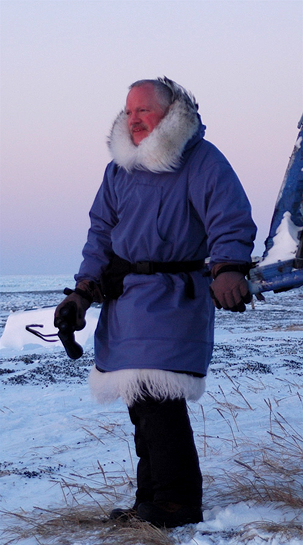The loud whirling screech of a snow machine accelerating, skimming across fresh pools of overflow tore the air up and down the windy wilderness of the Yukon River. It must be a springtime hunter in search of birds, foxes, and rabbits, I thought, while standing on the snowy bank and watching the rider disappear into the icy distance. Spring was arriving quickly this year because of a week of high temperatures. Grass and soil was already appearing beneath the passing winter snow and instead of walking in thick insulated boots I now wore thin rubber ones.
It had been a good winter, I thought while still standing there peering at the shimmering pools of water scattered about on the river ice. My mind wandered back to the past few months remembering willows clothed in snow and the long cold, colorful twilight in which two bright stars, one in the east and the other in the west would always emerge.
The spirit of the North has a stark but mysterious beauty in winter. On clear nights a vast gathering of stars would bath the sky in a celestial radiance giving the snow a bluish luster that sparkled magically in the night. The light of the moon and stars drifted through the clouds with the glow of a thousand different whirling spirits, while also shining enough light on the tundra to easily find my way. The tundra night has a subtle shimmer, a curious light that comes as much from the snow as from the glowing universe in the sky.
My hikes after dark across the frozen sloughs, lakes and under branching willows were full of wonder and beauty that was strengthened by a sense of intimacy with the land. An intimacy born from the willowy wind and the frozen earth, an intimacy that gives so much life, making me see these walks as a way to spend time studying with one of the greatest teachers: the natural landscape of our lives.
But the winter landscape could also be a harsh and unforgiving one, I thought while seeing another snow-machine racing, splashing through the melt-water and rushing up river. It was following the far bank hoping to avoid the large pools. The bluish spots were stands of fresh water while the slushy brown areas were sand bars thawing out. This made me think of the ice and all of its risks, being one of the many dangers that teach us how to live.
I turned away from the windy river and started walking down the dirt road back to the village of Emmonak. I remembered that as a first year teacher in the unfamiliar wilderness of Alaska, without any friends or family, I felt like I had fallen off the edge of the earth. I was a stranger in a strange land. But meeting the cheerful kids at school, the frost-bitten men in the sauna and the colorful Eskimo dancers, it was their kindliness that assured me that warm hearts lived here. Living and being challenged on foreign soil taught me much about humanity. It taught me about the nature of the journey we call life, a journey that struggles to teach us how to grow as real human beings.
The swirling arctic night sky with its mythic constellations also became a teacher during my snowy walks. Perhaps it was the stars in Orion that taught me how truth comes from within, from discoveries we experience in our wayward journeys, discoveries we sometimes make when we feel lost, alone and in the dark.
To let nature become your teacher requires a brave, steadfast soul. There is a wild and clever spirit living in the land and it is difficult to understand. But to learn how to boldly face this god-driven beast is to grow as a human being. This alone is a worth the pain of living. Just as learning how to teach another about the turbulent nature of life is one of the greatest of all virtues.

